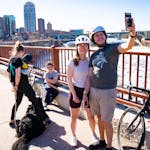A long-sought but elusive bicycle connection is expected to open this week in Minneapolis, forging a link that will allow a biker to pedal from Chaska or Victoria all the way to the Minnesota State Fair or the University of Minnesota's St. Paul campus without riding in general traffic.
The .77-mile connection runs under the heart of Dinkytown and connects Bridge 9 over the Mississippi River with the U's Transitway to St. Paul. It's now called the U Bikeway phase III, but there's a move to call it the Dinkytown Greenway.
The lighted segment is a good bet to become one of the most heavily used bike routes in the Twin Cities, according to Steve Clark, project manager for Bike Walk Twin Cities, which managed the federal funding that paid two-thirds of the $2.34 million cost.
The Dinkytown trail connection originally was proposed more than 20 years ago. It links Bridge 9, a former Northern Pacific railroad bridge that the city rehabbed in 2000 for bikers and pedestrians, with the west end of the Transitway, which ends near the Gophers football stadium.
The original plan was for the west end of the connection to hook up with the Stone Arch Bridge for a more direct connection into downtown Minneapolis. But after two failed attempts by the city to negotiate with the adjoining Burlington Northern Santa Fe railroad, the university offered an easement without charge over its land. That saved the project so much money that another significant bike connection will be partly funded with the savings when it's built next year.
That's the Bluff Street Trail, which will link the west end of Bridge 9 with 13th Avenue S. and then 2nd Street S. bike lanes into downtown. The trail is about one-quarter mile long. This segment will run under Interstate 35W, through a large concrete culvert installed in 2008 when the 35W bridge was built after the collapse of its predecessor.
That's a $2.2 million project, with the city supplying half of the money and the federal and county government the rest. That's atop the $841,500 the city spent installing the culvert to preserve the possibility of the trail being built. The city had long planned the trail but hadn't yet put it in its bike master plan when the bridge collapsed, which cost it the chance to have the feds pay for the culvert.
There's an indirect connection to downtown now from the west end of Bridge 9 but it involves traveling downhill to West River Parkway and then uphill again on the parkway bike path. Bridge 9 carried about 600 bikers and about 400 walkers daily in a 2012 count.
The Dinkytown trail is expected to open in a few days once items noted in a post-construction inspection are completed.
Both bike projects rely in part on the $28 million in federal money directed to the Twin Cities, one of four locations funded by the federal Non-Motorized Transportation Pilot Program, championed by former congressman James Oberstar.
Steve Brandt • 612-673-4438
Twitter: @brandtstrib



